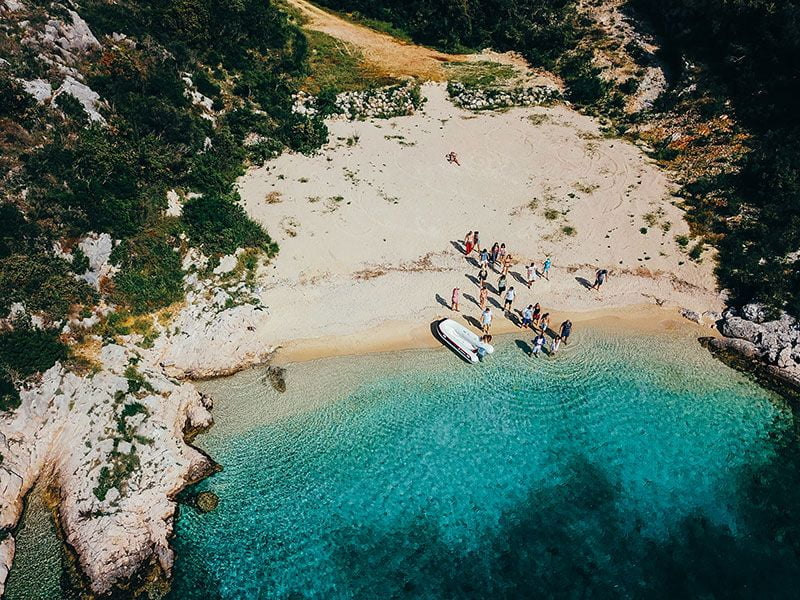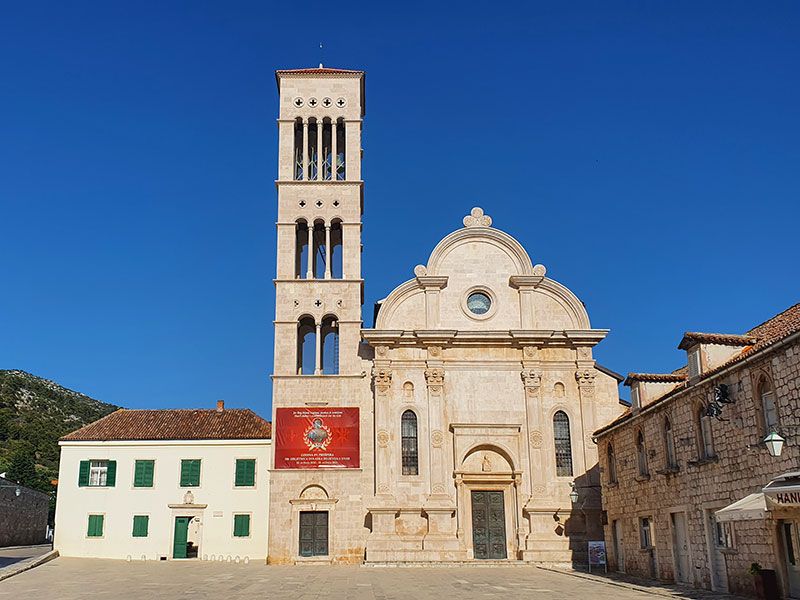The largest town on the island of Hvar is the town of the same name, with its seaside promenade surrounded by palm trees and city walls from the 7th century. The white stone houses give the village a medieval atmosphere. What to do in Hvar? We will show you the best holiday activities.
This article gives you an overview of the following topics:
- Things to do in Hvar: The most beautiful beaches
- What to do in Hvar: Nature is calling
- Things to do in Hvar: Discover the highlights of the town!
- Traditions and events in Hvar
- Gastronomy of Hvar
Things to do in Hvar: The most beautiful beaches
The beaches in Hvar are mostly rocky and pebbly, with crystal clear waters. The Pokonji Dol lies about 2 kilometres from the town, but the Mekićevica is also a great choice. It is also nearby, about 2.5 kilometres from Hvar. There are beautiful beaches on the island of Pakleni, near the bay. We recommend visiting Jerolim, Ždrilica and Palmižana beaches. The Pakleni Islands are very popular among tourists and divers as well. One of the best places to go diving is Sika or Vodnjaka, east of the island of Veli Vodnjak. The 46-meters-high Kampanel Reef is a must-see.
What to do in Hvar: Nature is calling
You can get to the beautiful Pakleni Islands from the port by water taxi. The archipelago consists of twenty smaller islands. Locals call them ‘Forski školji’. The Sveti Klement island is very popular among locals and tourists. It is the largest island with its size of 5, 3 square kilometres. The pine, cactus, rosemary and laurel forests make it especially beautiful. A botanist, Eugen Meneghello planted an arboretum with plants that domesticated over the centuries. If you are looking for some peace and quiet, there are several secluded bays with crystal clear water on the island.
Momića Polje, Vlaka and Palmižana are the three towns on Sveti Klement, but local residents only stay here during the summer season. Besides Palmižana, Zdrilica, the Sveti Jerolim Island and Marinkovac are also great holiday destinations.
Things to do in Hvar: Discover the highlights of the town!
The town has a very rich history, it boasts some impressive buildings. We recommend visiting churches and other interesting places.
Fortica Fortress
The Fortica Fortress is also called Tvrđava Španjola. Construction began in 1278 in the form of a citadel, after the Island of Hvar was brought under Venetian control. The building and the city walls protected the town. In the 16th century, they built a new fortress, which served as a refuge for locals during the Turkish invasion in 1571. Fortica acquired its present form after many reconstructions. It was restored in 1579 following a gunpowder explosion. It was further expanded under French and Austrian rule. Nowadays, the fortress is a major tourist attraction, offering wonderful views not only over Hvar but the surrounding islands. In addition, there are significant medieval and even older findings on the exhibit.
The other fortress in the town is the Napoleon Fortress from 1811. It stands on the northeastern side of the island, on the St. Nicholas Hill. The fortress was used as a lookout point, but you can also find a chapel here. Today, it is home to an observatory.
Main Square
Located in the heart of the city, Pjaca is the largest square in Dalmatia with its size of 4500 square metres. It was once surrounded by gardens. You can see buildings here like the Cathedral of St. Stephen, the Episcopal Palace or the Governor’s Palace. There is a well in the middle of the square, in front of the cathedral that was built-in 1520.
Cathedral of St. Stephen
The Renaissance-Baroque cathedral is one of the most outstanding architectural monuments in Hvar. Located in the eastern part of the main square, the cathedral was built on the foundations of a 6th-century Christian Church and the Benedictine Convent of St Mary. It dates back to the 16-17th centuries, but the interiors were only finished by the 18th century. Of the eleven Baroque altars, the ones facing each other are identical, made by Venetian craftsmen.
Church of St. Mark
The former Dominican Monastery was first mentioned in 1312. You can visit its remains that date from the 16-17th century. As the aristocrats of Hvar used to meet here, there are the altars and tombs of old noble families. The archaeological collection consists of more than 2500 pieces: stones, bones, pottery, decorative items, reliefs, and oil lamps.
Loggia and the Clock Tower
There is a Clock Tower from the 15th century on the north side of the main square, next to the semi-open arcaded hall, the Loggia. You can also find the remains of the Governor’s Palace here. The Turks destroyed the Loggia in 1571. Later a Croatian mason master, Trifun Bokanić rebuilt it in Renaissance style in the 17th century. It had served as a coffee house since 1868, and today it functions as a reception and exhibition hall.
Theatre
The first public theatre in Europe was opened in the picturesque Hvar in 1612. The Arsenal or the armoury is on the second floor. It acquired its current Neo-Baroque form in the mid-19th century. There is a small museum in the main hall where you can see the paintings of contemporary Hvar-based painters. The two frescoes date from 1819.
Traditions and events in Hvar
The Island of Hvar is home to the Hvar Summer Festival that lasts for about 100 days. You can see several concerts, theatre and folklore performances during the festival. One of these events is the Lavanda Festival in June, in the nearby Velo Grablje.
Every town on the island hosts a Fisherman’s night. In addition to music and fish, bread, wine, and olive oil are also play an important role. Another important event is the festival of Hvar wines, the Wine Festival in the nearby Jelsa.
The best nightclubs
The Mediterranean Hvar offers many entertainment options. One of the best nightclubs is the Hula Hula Bar, west of the city, in front of Hotel Croatia. It is also worth visiting the Carpe Diem beach on the Pakleni Islands where you can go partying during the day as well. You can go swimming listening to light, Latino rhythms, while in the evenings a real nightclub atmosphere awaits those who want to have some fun. On Saturday nights popular DJs bring the music to you. The indoor Pink Champagne club is also a great choice, characterised by luxury and glamour.
Gastronomy of Hvar
There are several restaurants in the town, offering traditional Croatian and international dishes as well. You can pair the delicious food with a bottle of wine. Since the slopes of the island of Hvar – especially on the southern side – are exposed to constant sunshine, it is one of the best wine growing regions. In addition to Placnic, you can try a unique drink, red wine with sheep’s or goat’s milk.
One of the most famous restaurants in the town is Dalmatino. It is characterised by quality food and drinks, a pleasant atmosphere and polite service. If you choose this place, you should make a reservation in advance.
The family-run Luna Grande is also a great choice with its cosy roof terrace. We recommend the delicious, traditional seafood dishes.
In this article, we have introduced the best holiday activities in Hvar. If you choose this port town, you will not only find crystal clear beaches but also beautiful historic monuments. The local, high-quality Dalmatian delicacies and wines make your holiday truly unforgettable. Read more if you plan Hvar sailing or rent a boat in Hvar.




